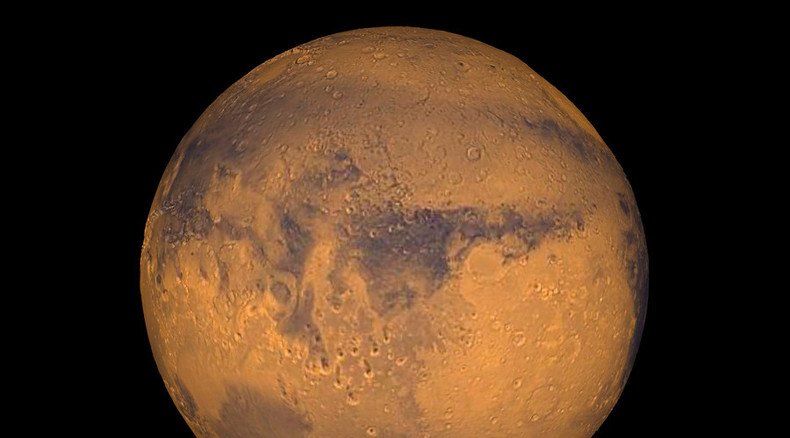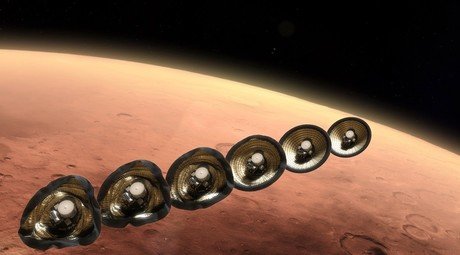NASA confirms: Mars has liquid water

For the first time, NASA has confirmed the existence of liquid water on the surface of Mars, according to new research announced Monday. The finding stems from data and analysis by NASA's Mars Reconnaissance Orbiter.
The Mars Reconnaissance Orbiter (MRO) has verified that the dark, seasonal streaks that have appeared on Mars' surface come from briny water flows.
Miss today's #MarsAnnouncement? Here's the highlights on evidence that liquid water flows on present-day Mars:
https://t.co/sFKSJo7VqD
— NASA (@NASA) September 28, 2015MRO found evidence of narrow channels containing water cut into cliff walls through Mars' equatorial band, though the source and chemistry of the water is yet unknown. The streaks, or recurring slope lineae, appear during the warmer summer months on the Red Planet. They disappear when the temperature drops.
Tweetchat: Water on Mars! Question about our new discovery? Use #askNASA now http://t.co/0MW11SANwL#MarsAnnouncementpic.twitter.com/UbBtn9eU7P
— NASA (@NASA) September 28, 2015The findings advance the potentiality for life on Mars, researchers said. While it is likely that life exists in the crust of Mars, the new findings further the possibility of life closer to the surface of the planet, Alfred McEwen, a planetary scientist with Arizona State University, said during a NASA press conference.
Look at it! Look at the water! http://t.co/l9lIZuBidrpic.twitter.com/3j8sm8QpQn
— Sean O'Kane (@sokane1) September 28, 2015“It took multiple spacecraft over several years to solve this mystery, and now we know there is liquid water on the surface of this cold, desert planet,” said Michael Meyer, lead scientist for NASA’s Mars Exploration Program. “It seems that the more we study Mars, the more we learn how life could be supported and where there are resources to support life in the future.”
"These are dark streaks that form in late spring, grow through the summer & disappear in the fall" #MarsAnnouncement
https://t.co/Q9wcpY28dn
— NASA (@NASA) September 28, 2015Scientists had previously run into difficulties analyzing the streaks, which measure less than 16 feet, or 5 meters, wide. The MRO's instruments were able to process trace measurements, and scientists successfully observed the findings thanks to a computer program that can focus in on individual pixels. MRO's data was then compared with high-resolution images of the slopes. Scientists found a match between their locations and the presence of hydrated salts.
"We're not claiming that we found ... evidence of liquid water. We found hydrated salts," said Lujendra Ojha, a graduate student at Georgia Institute of Technology and lead author of the report, published in the journal Nature Geosciences.
READ MORE: Design for 3D printed Mars base unveiled
While NASA has rushed to announce the findings, Ojha expressed reserve.
"It's a little bit over-the-top announcement by NASA," Ojha said. "There's so many mysteries to be solved about RSL (recurring slope line)."
The presence of water on Mars in the form of ice caps has been known for years. However, proof of liquid water on the Red Planet will have major ramifications for the study of Mars. It may mean that microbial life may still survive under the Martian surface, if there ever was any in the first place.
READ MORE: Stonehenge on Mars? UFO hunter spots strange rock formation on red planet
The discovery "confirms that water is playing a role in these features," according to McEwen. "We don't know that it's coming from the subsurface. It could come from the atmosphere."
NASA's Mars rover Curiosity previously found evidence that Mars had suitable conditions for microbial life that existed at some point in the past.
READ MORE: Astronaut Scott Kelly on space work: What time zone is on ISS & where veggies & drugs come in
During the summer, Mars can reach up to 70 degrees Fahrenheit along its equator. Ojha and his research team found that this high temperature -- far from the planet's average of -80 degrees Fahrenheit -- allowed salty water to flow down the planet's slopes. The water combines with perchlorates to form a brine solution that helps the water to remain a liquid as temperatures drop.
READ MORE: NASA’s ‘Mars Trek’ could help find human landing sites on Red Planet
"We found the hydrated salts only when the seasonal features were widest, which suggests that either the dark streaks themselves or a process that forms them is the source of the hydration. In either case, the detection of hydrated salts on these slopes means that water plays a vital role in the formation of these streaks," Ojha said.














